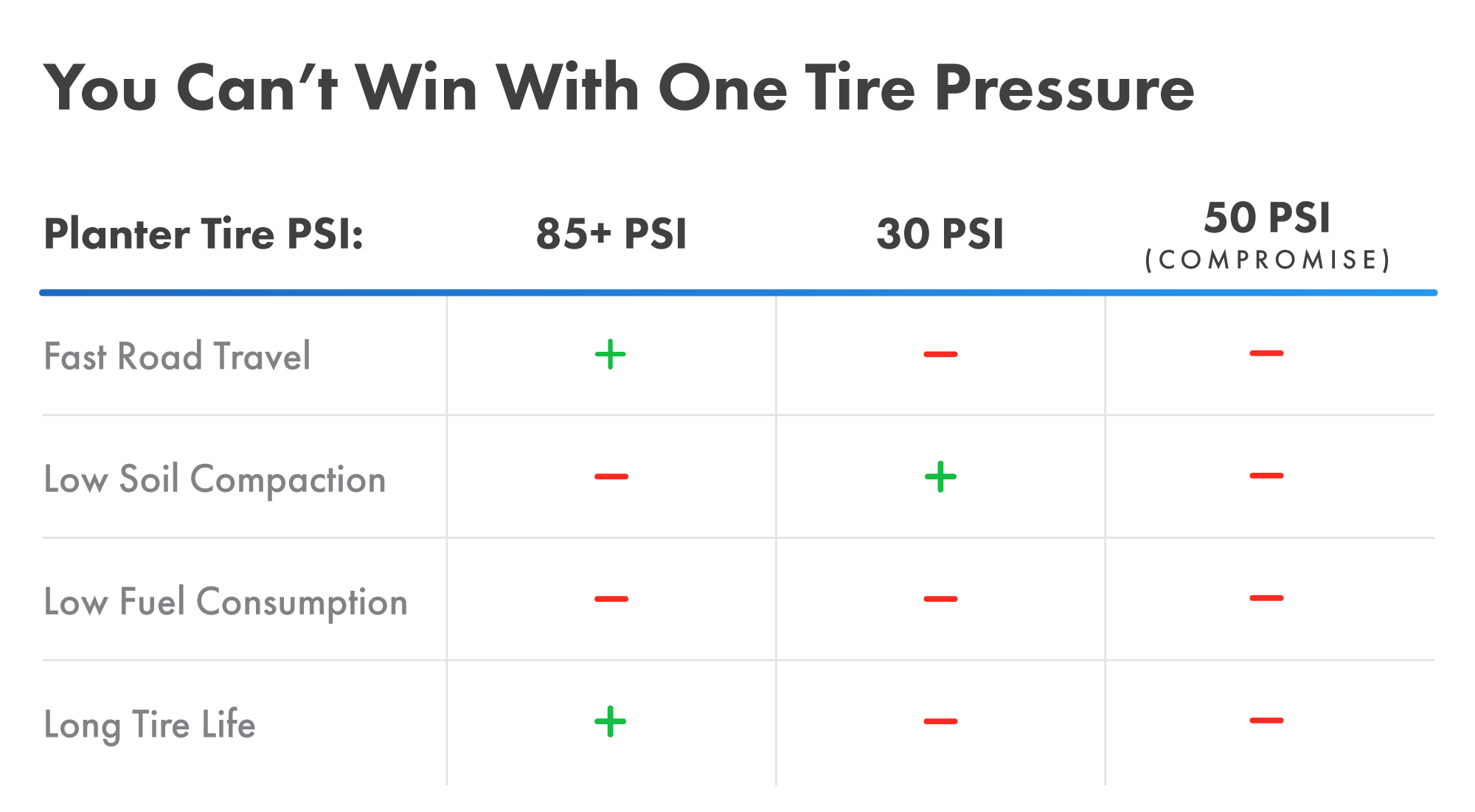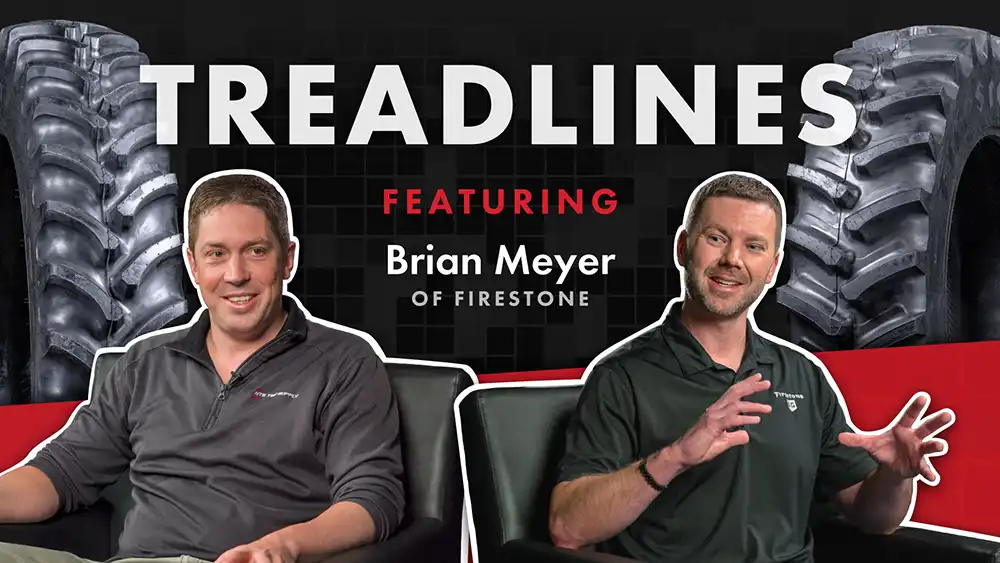Today’s massive planters keep you rolling longer because they can carry enormous amounts of seed and fertilizer. But at what cost? All that weight adds up to compaction and, eventually, reduced yields and lower profitability. Here’s the basic problem:

High Pressure Adds Up to Compaction
- You must inflate your planter’s tires to 85 PSI or more to safely handle high road speeds.
- Those same 85-PSI truck tires then squash your yields through compaction in the field. If you could run those same truck tires at 30 PSI, they would give you a much bigger contact patch and more flotation. But 30 PSI would never cut it on the road, unless you like guzzling fuel and destroying tires.
- So do you split the difference and run them at 50 PSI? On the road, the pressure’s still too low. And in the field, you won’t see any useful benefit in your fight against compaction either because the pressure’s still too high.
Forget compromise. If you want to solve this problem, it’s time to invest in a central tire inflation system.

A Central Tire Inflation System Puts You In Control
Companies selling everything from herbicides to side-by-sides want to “put you in control.” Whether that promise sticks is another matter. When you outfit your planter and planter tractor with a central tire inflation system, you actually are in control. You can set optimum tire pressures for both road travel and field work at the touch of a button from your tractor seat. No compromise necessary.

Maximize Your Time on the Road at Max PSI
- Travel faster. Safely run at your tractor’s top speed instead of slowing down to avoid damaging underinflated tires.
- Save fuel. Less rolling resistance means easier pulling.
- Ride better. Navigate narrow roads and corner with confidence on stiff tires, which sway much less than a tire inflated to the typical “compromise pressure.”
- Save money on tires. 90% of tire wear happens on the road where heat is high and the surface is abrasive. Proper tire pressure prevents your tread from slipping or rubbing against the road. Running at max PSI down the road will extend the life of your tires.
Maximize Field Performance at Minimum PSI
- Create less compaction. Lower tire pressure = bigger tire footprint. You spread the weight of your machine over a larger area, which translates to less ground pressure and less compaction. Compaction destroys the soil structure, makes it harder for plants to obtain nutrients, and can create ponding water and other drainage problems.
- Minimize stunted crops. The crop rows sandwiched between your planter’s center tires and tractor rears are especially vulnerable to compaction and stunted growth. If you run a 24-row planter, 25% of your rows are pinch rows. A quarter of your crop isn’t reaching its full potential!
- Work faster. A larger tire footprint gives you more traction and less slip. What if this translated to an extra mph of ground speed? It’s possible when every revolution of your tires moves you farther forward.
- Save money on fuel. When you fight compaction, you also fight high fuel bills. According to PTG, for every .4 inch a towed machine sinks into the soil, your fuel consumption increases 10%. The extra work for your tractor would be the equivalent of pulling a constant 1% grade. If your tires are sunk in 4 inches, this balloons to a constant 10% grade!
Read More: Keep Farm Tire Pressures Low for Higher Profits

A Central Tire Inflation System Puts You in Total Control
You turn it on and it just works. Control your system from an ISO monitor or digital control box from the driver’s seat. No valves to turn and no time-consuming maintenance to perform.

Push a button when you want to change pressure. The target inflation time is usually between 3 and 5 minutes. Leaving the field to run down the road? Hit the inflate button. By the time you’re down the road one mile, your tires are at their pre-set ideal road pressure. Deflating to your pre-set field pressure takes only 90 seconds. Hit the deflate button as you’re turning into the field.
You get a custom system delivered, not a box of random parts. You receive a custom kit that includes all the system components you need.
Inflation systems fit most popular planter models. Whether you’re running with Deere, Case, Kinzie, or another brand, chances are you can outfit your planter with a system. And you may want to add an inflation system to your planter tractor as well.
How Much Does an Inflation System Cost?
There are many factors that influence the price. For one, we sell systems from both AgriBrink and PTG. The number of tires on each axle, the type of monitor you want, and the size of compressor you'll need to install are a few of the variables that affect price. With planter installations, some farmers choose to equip just the planter, while others opt to also equip the planting tractor's axles with the system as well, which we recommend (unless your planting tractor has tracks, of course).
Read More: Farmers' Frequently-Asked Questions about CTIS
The real question is, "how much is it going to cost you to NOT install a system?"
You Might Not Spend a Dime in the Long Run
When you factor in the system ROI, you may not spend one dime in the long run. According to Michelin, owner of PTG Tire Inflation Systems, a central tire inflation system can deliver:

What about Tracks? Stick with Tires and Save BIG!
Let’s use a John Deere 24-row NT planter as an example. An OEM track system is a $55,000 upcharge. A John Deere 8-series tractor, configured with 4 tracks instead of tires, breaks the bank with a $110,000 upcharge. Do tracks keep you in the field in all types of conditions? Sure. Do they offer the same protection against compaction? In short, no. At NTS Tire Supply, we've looked at the issue of tires versus tracks before.
Plus, tracks increase your maintenance and fuel costs over the life of your machine(s). With high-tech IF/VF radials and a central tire inflation system, you can beat the performance of tracks on your planter setup while saving money.
Combat Compaction and Boost Your Bottom Line
At NTS Tire Supply, compaction is the #1 problem we help farmers solve through smart traction strategies. Why? Because it’s costing your operation a lot of money!

Spring into Action to Stop Compaction
As we’ve said again and again, compaction is the #1 profit-robber NTS Tire Supply customers face. And a central tire inflation system on your planter (or your planter + planter tractor) can potentially pay huge dividends for your operation, as we’ve shown you above. As with any other traction technology, such as IF/VF radials, the initial investment can seem steep.
Until you remember the potential ROI:
- Increased yields
- Faster fieldwork
- Extended tire life
- Faster, safer road travel
- Better ride
Is a CTIS the right move for your farm? How many more bushels will you be able to add to your bins if you take steps to tackle pinch row compaction? Call and speak with a CTIS expert before spring planting gets rolling and drive your farm forward.

.png)
.jpg)



















